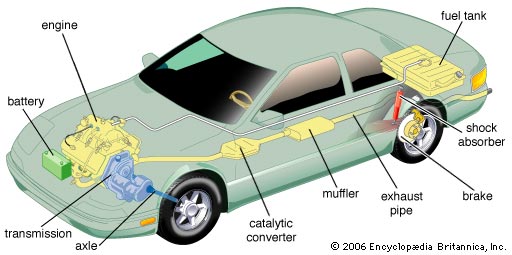In modern society, cars are so abundant and common that it is hard to imagine a world without SUVs, lightweight trucks, and cars in a variety of different sizes and classes. Back in the early 18th century, however, automobiles had not yet been invented, and horses were still the common means of transportation. The first successful effort to create an automobile occurred in 1769 when Nicolas Cugnot, a French inventor, created a slow-moving, steam-powered vehicle that ran on three wheels. Although it is technically considered the first car, it did not use an engine similar to the one used in modern vehicles. That distinction goes to an inventor in Switzerland named Francois Isaac de Rivaz. In 1807, Rivaz invented an internal combustion engine that ran on hydrogen and oxygen fuel. He built a car for this engine that although not successful, was the first internal combustion car. History often names Carl Benz as the first creator of the automobile; however, Benz's automobile was designed in 1885, nearly 80 years after Rivaz's auto.
Engine - An engine is a vehicle's power source. The car engines in most modern vehicles are internal combustion engines. This means that they burn the car's gasoline in order to convert it into mechanical energy that will ultimately power the vehicle.
Brake - A vehicle's brakes, or brake system, is the system which slows the vehicle and enables it to come to a stop when necessary. It is one of the most important features on a car, truck, or other vehicle in that it allows the driver to control it safely. When a driver presses his or her foot on the brake pedal, the force pushes the brake shoes against the brake drums. It also pushes the pads against the disc brakes, or rotors. This creates a friction that causes to vehicle to slow, or depending on the amount of pressure applied to the brake pedal, stop.
Electrical System - The electrical system produces and stores electricity for electric accessories and features of a car. One of the major parts of this system is the battery; however there are other parts to the system including the starter motor, alternator, generator, voltage regulator, and fuse panel.
Cooling System - The purpose of a vehicle's cooling system is to keep the engine cool and prevent damage from excessive heat. It consists of a radiator, thermostat, water pump, fluid coupling, cooling fan, hoses, and the water jacket. The system cools the engine by circulating an engine coolant. In some cases, the cooling system uses air that is blown from an engine driven fan to keep the engine cool.
Fuel System - The fuel system consists of the fuel pump, fuel filter, fuel injectors, and the fuel lines. It is the system that holds and delivers the fuel that is needed to power a vehicle. When in operation, fuel from the fuel tank passes through the fuel filter. From the fuel filter the cleaned fuel is sent to the fuel injectors and into the engine.
Steering - Steering is a system that connects the steering wheel to the wheels of the vehicle. The steering system allows the driver to maneuver the car in a specific direction with minimal effort or force applied to the wheel. In most cars, steering is power-assisted.
Transmission - The transmission is a piece of machinery that works with the car's engine to turn the wheels and drive the car. Transmissions are either manual or automatic and they help power the car by turning the speed of the engine into torque.
-
Automatic Transmissions
Suspension - Suspension works with steering in its interaction with the wheels and helps control the vehicle. It absorbs the impact of the wheels against the road to ensure a smoother ride.
Wheels and Tires - All cars and personal lightweight trucks come with four wheels that are covered by rubber tires. The tires are the part of the vehicle that comes into contact with the road's surface and enables the car to physically move. They are made to endure the weight of the vehicle and its passengers and cargo. The tire's grip on the road is determined by the tread, which wears down over time and eventually requires replacement.
Accessories - Auto accessories are car parts that improve the performance of a vehicle. Many accessories are standard in all cars and trucks, including the horn, headlights, and speedometer. Certain accessories, such as air conditioning and the radio, are meant to boost the comfort and enjoyment of the driver and passengers. Other accessories such as car mats, car bras, and seat covers are meant to enhance the vehicle's appearance.

 Live Chat
Live Chat



